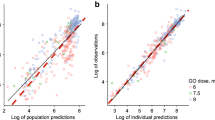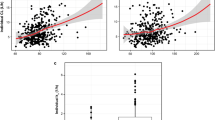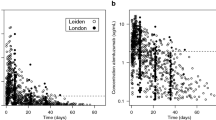Abstract
Background and Objective
Gemtuzumab ozogamicin is an antibody–drug conjugate composed of the anti-CD33 monoclonal antibody hP67.6 covalently linked to N-acetyl-gamma-calicheamicin dimethylhydrazide, a potent cytotoxic antibiotic. The aim of this study was to characterize the population pharmacokinetics of gemtuzumab ozogamicin, represented by total hP67.6 antibody and unconjugated calicheamicin, in adult patients with acute myeloid leukemia to support drug dosing strategies and explore intrinsic and extrinsic factors that may influence exposure. Pharmacokinetic data from seven previous phase I and II studies in adult patients with relapsed, refractory, or de novo acute myeloid leukemia were integrated and analyzed using nonlinear mixed-effects modeling.
Methods
The pharmacokinetics of total hP67.6 antibody was described in 407 patients (5643 concentrations) who received gemtuzumab ozogamicin doses ranging from 0.25 to 9 mg/m2 using a two-compartment model with linear and time-dependent clearance components. The pharmacokinetics of unconjugated calicheamicin was characterized in 338 patients (4281 concentrations) using a two-compartment model with an input rate of formation dependent on the amount of hP67.6 eliminated. No statistically significant baseline covariates (sex, albumin, bone marrow, and peripheral blast percentage) demonstrated a clinically meaningful impact.
Results and Conclusion
Total hP67.6 antibody disposition did not appear altered in patients with mild or moderate renal disease or hepatic impairment. Gemtuzumab ozogamicin was approved for the treatment of acute myeloid leukemia by the US Food and Drug Administration in September 2017. The model-based simulations described here provided a pharmacokinetic rationale for the approved dosing regimen of 3 mg/m2 on days 1, 4, and 7, and served as the basis for all exposure–response modeling included in the recent Biologics License Application submission. Clinical trials identifiers: 0903A1-101-US; 0903A1-103-JA; 0903B1-201-US/CA (NCT00003131); 0903B1-202-EU; 0903B1-203-US/EU (NCT00003673); 0903B1-205-US/EU/AU (NCT00037596); and 0903B1-206-US/EU/AU (NCT00037583).




Similar content being viewed by others
References
Thol F, Schlenk RF. Gemtuzumab ozogamicin in acute myeloid leukemia revisited. Expert Opin Biol Ther. 2014;14(8):1185–95.
Zein N, Sinha AM, McGahren WJ, et al. Calicheamicin gamma 1I: an antitumor antibiotic that cleaves double-stranded DNA site specifically. Science. 1988;240(4856):1198–201.
Ehninger A, Kramer M, Rollig C, et al. Distribution and levels of cell surface expression of CD33 and CD123 in acute myeloid leukemia. Blood Cancer J. 2014;4:e218.
Bross PF, Beitz J, Chen G, et al. Approval summary: gemtuzumab ozogamicin in relapsed acute myeloid leukemia. Clin Cancer Res. 2001;7(6):1490–6.
Larson RA, Sievers EL, Stadtmauer EA, et al. Final report of the efficacy and safety of gemtuzumab ozogamicin (Mylotarg) in patients with CD33-positive acute myeloid leukemia in first recurrence. Cancer. 2005;104(7):1442–52.
Petersdorf SH, Kopecky KJ, Slovak M, et al. A phase 3 study of gemtuzumab ozogamicin during induction and postconsolidation therapy in younger patients with acute myeloid leukemia. Blood. 2013;121(24):4854–60.
Wyeth Pharmaceuticals Inc. (a subsidiary of Pfizer Inc). Mylotarg® (gemtuzumab ozogamicin; PF-05208747) FDA Oncologic Drugs Advisory Committee Briefing Document (BLA 761060). https://www.fda.gov/downloads/AdvisoryCommittees/CommitteesMeetingMaterials/Drugs/OncologicDrugsAdvisoryCommittee/UCM566015.pdf. Accessed 30 Apr 2018.
Godwin CD, Gale RP, Walter RB. Gemtuzumab ozogamicin in acute myeloid leukemia. Leukemia. 2017;31(9):1855–68.
van Der Velden VH, te Marvelde JG, Hoogeveen PG, et al. Targeting of the CD33-calicheamicin immunoconjugate Mylotarg (CMA-676) in acute myeloid leukemia: in vivo and in vitro saturation and internalization by leukemic and normal myeloid cells. Blood. 2001;97(10):3197–204.
van der Velden VH, Boeckx N, Jedema I, et al. High CD33-antigen loads in peripheral blood limit the efficacy of gemtuzumab ozogamicin (Mylotarg) treatment in acute myeloid leukemia patients. Leukemia. 2004;18(5):983–8.
Caron PC, Jurcic JG, Scott AM, et al. A phase 1B trial of humanized monoclonal antibody M195 (anti-CD33) in myeloid leukemia: specific targeting without immunogenicity. Blood. 1994;83(7):1760–8.
Castaigne S, Pautas C, Terre C, et al. Effect of gemtuzumab ozogamicin on survival of adult patients with de-novo acute myeloid leukaemia (ALFA-0701): a randomised, open-label, phase 3 study. Lancet. 2012;379(9825):1508–16.
Sievers EL, Appelbaum FR, Spielberger RT, et al. Selective ablation of acute myeloid leukemia using antibody-targeted chemotherapy: a phase I study of an anti-CD33 calicheamicin immunoconjugate. Blood. 1999;93(11):3678–84.
Larson RA, Boogaerts M, Estey E, et al. Antibody-targeted chemotherapy of older patients with acute myeloid leukemia in first relapse using Mylotarg (gemtuzumab ozogamicin). Leukemia. 2002;16(9):1627–36.
Dowell JA, Korth-Bradley J, Liu H, et al. Pharmacokinetics of gemtuzumab ozogamicin, an antibody-targeted chemotherapy agent for the treatment of patients with acute myeloid leukemia in first relapse. J Clin Pharmacol. 2001;41(11):1206–14.
National Kidney Foundation. K/DOQI clinical practice guidelines for chronic kidney disease: evaluation, classification, and stratification. Am J Kidney Dis. 2002;39(2 Suppl. 1):S1–266.
Patel H, Egorin MJ, Remick SC, et al. Comparison of Child–Pugh (CP) criteria and NCI organ dysfunction working group (NCI-ODWG) criteria for hepatic dysfunction (HD): implications for chemotherapy dosing. J Clin Oncol. 2004;22(14 Suppl.):6051.
Li J, Zhi J, Wenger M, et al. Population pharmacokinetics of rituximab in patients with chronic lymphocytic leukemia. J Clin Pharmacol. 2012;52(12):1918–26.
Gibiansky E, Gibiansky L, Carlile DJ, et al. Population pharmacokinetics of obinutuzumab (GA101) in chronic lymphocytic leukemia (CLL) and non-Hodgkin’s lymphoma and exposure–response in CLL. CPT Pharmacomet Syst Pharmacol. 2014;3:e144.
Acknowledgements
Lauren D’Angelo, PhD, and Kevin O’Regan, PhD, of Complete Healthcare Communications, LLC (a CHC Group company), and David Wateridge, PhD, of Engage Scientific Solutions, provided editorial support and their assistance was funded by Pfizer Inc.
Author information
Authors and Affiliations
Corresponding author
Ethics declarations
Funding
The study was sponsored by Pfizer Inc.
Conflict of interest
Jennifer Hibma is an employee and stockholder of Pfizer Inc. Beverly Knight was employed by Pfizer Inc. at the time of study and manuscript development and is a stockholder of Pfizer Inc.
Ethics Approval
All studies were conducted in accordance with the principles of the Declaration of Helsinki and the International Conference on Harmonisation Guidelines for Good Clinical Practice. Each study protocol was approved by the ethics committee at participating study centers.
Consent to Participate
Informed consent was obtained from all individual participants included in each study.
Additional information
Beverly Knight was employed by Pfizer Inc at the time of the study and manuscript development.
Electronic supplementary material
Below is the link to the electronic supplementary material.
Rights and permissions
About this article
Cite this article
Hibma, J., Knight, B. Population Pharmacokinetic Modeling of Gemtuzumab Ozogamicin in Adult Patients with Acute Myeloid Leukemia. Clin Pharmacokinet 58, 335–347 (2019). https://doi.org/10.1007/s40262-018-0699-5
Published:
Issue Date:
DOI: https://doi.org/10.1007/s40262-018-0699-5




